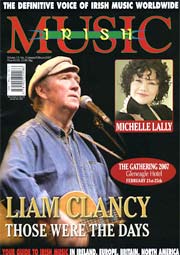
From the Outside Looking In: This month I had the pleasure of reviewing a different kind of book about Irish Music, Gabriele Haef's Chinese Transvestites and Other Stories, yet it is as strange as the title suggests. Part of its appeal and a lot of its character comes from it being compiled by a German editor.
The start of the year was dominated by one event, the Charlie Hebdo assassination in Paris. An assassination. of journalists who made political cartoons. Grotesque comic cartoons, in the living tradition of dissent and secularism at the heart of the French social contract. If Haefs goes out of her way to be generous, Charlie Hedbo's mission is to offend, forever the grinning gargoyle on the Gothic cathedral.
At the Irish Music Magazine / FolkWorld* we have never gone out of our way to offend or cynically criticise, in our twenty years of reporting we have never been that kind of publication. At the heart of the dilemma for anyone publishing in the public domain is a swinging bascule between disinterested journalism and gonzo participation. Disinterest is not un-interest, the disinterested see many sides to a story, offer contradictory or counter-intuitive insights and walk away leaving the reader to make up their own mind. Gonzo journalists put themselves in the middle of the action, their feelings and reactions become the story.
In an arts magazine, there is a call for both effective and effective reporting. Here at IMM everyone of our correspondents has some involvement in music beyond writing about it, we cherish them for their insider insights. But I am mindful that a touch of gonzo adds colour yet too much makes muppets of us all. Our aim over those twenty years has been to give you, the reader, a disinterested balance, a publication where our correspondents do not grind their axes on the reputations of the talented. Musicians and their stories are always central to what we do, they may be marginal in the popular press but here the players take the spotlight.
The Charlie Hebdo assassination was appaling criminal barbarity. In the aftermath a few commentators discussed the limits of satire, not just those imposed by good taste but by accuracy and fairness.
Cartooning and humour have a long history and if you select your images you can make a case that they are for the general good. The Irish experience would say otherwise. Throughout the 19th century both in Britain and the USA, Irish immigrants were depicted as being sub human simian simpletons, caricatured by a press that was eager to sell its bigotry and racism to a WASP clientele, peddling pictures for profit to an establishment who saw Irish Catholics as threats to their control over the obedient Hoi Polloi. Thomas Nast demonised the Irish in the USA for over 30 years. He created many images in his lifetime, had huge political influence. even invented the enduring versions of Uncle Sam and Santa Clause, such was the power of his viusal art.
The most violent and lazy kind of satire is when it manufactures the flaws of the alien, when it cannot imagine another way of thinking, or acting, or making merry, when it fails to appreciate other ways of being culturally complex, coherent and complete. Satire is at its most potent when it punctures the balloons of the powerful and privileged, when it is vertical not horizontal.
In Gullivers Travels, Jonathan Swift's warring tribes debate and go to war over whether it is best to smash or slice the round or pointed end of an egg. A comic reflection on the two kinds of Christianity he knew in the early 1700's. The currency of caricature is reductive simplicity, not funny when it is used to attack cultural groups, unfair and unfounded when those who are attacked are unable to reply in kind.

My old pal Liam Clancy said "look for the universal in a folk song, look for the good in it." An immigrant Irishman in Greenwich Village he made a lasting mark by both being different and by embracing the excitement of that most marvellous and alien of places. After he sang in the White Horse Tavern, no one could pin a Nast cartoon on the Clancys.
Respect Charlie, Respect.
Until the next time... Slán, Seán Laffey
* First published @ Irish Music No. 237 March 2015
(www.irishmusicmagazine.com).